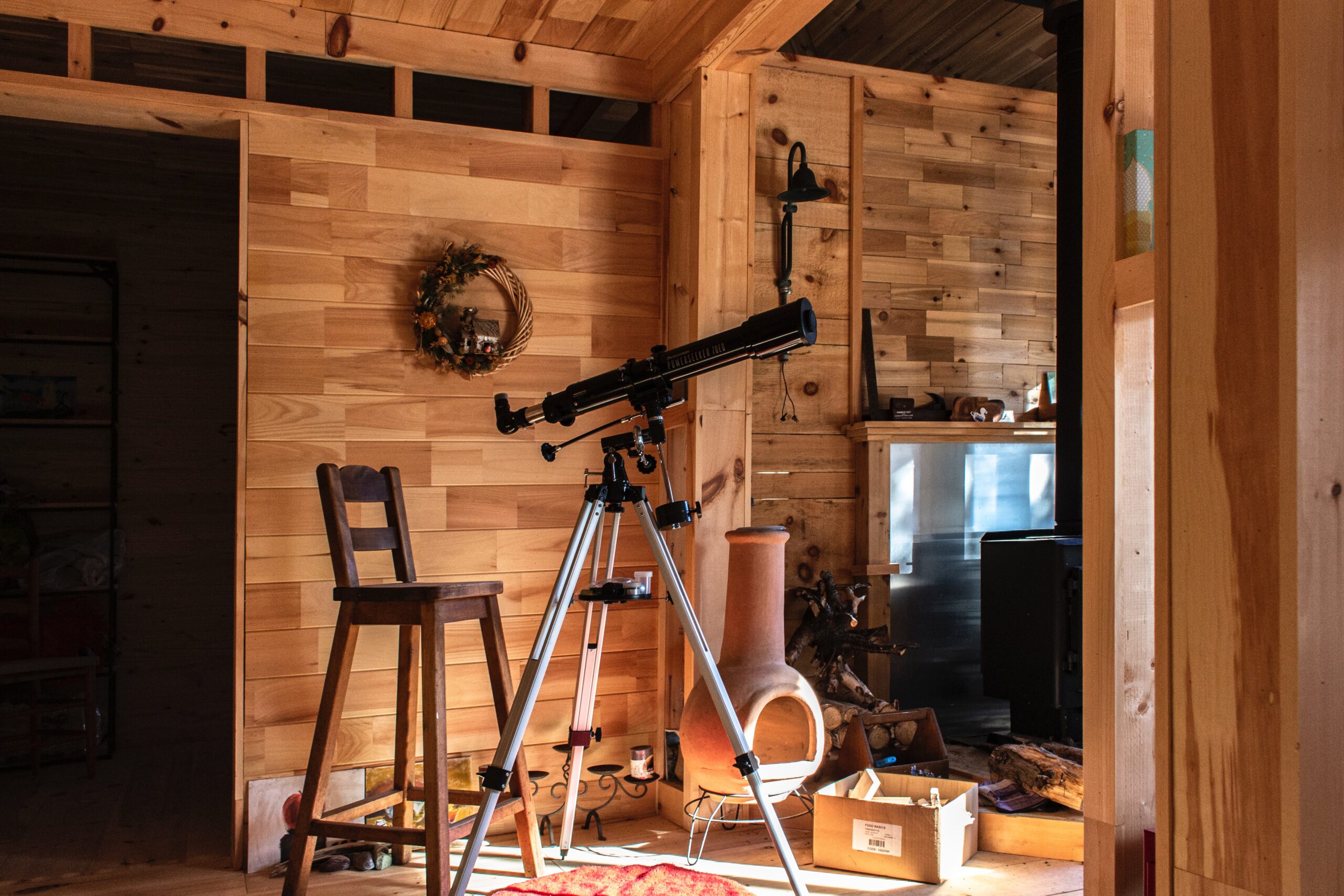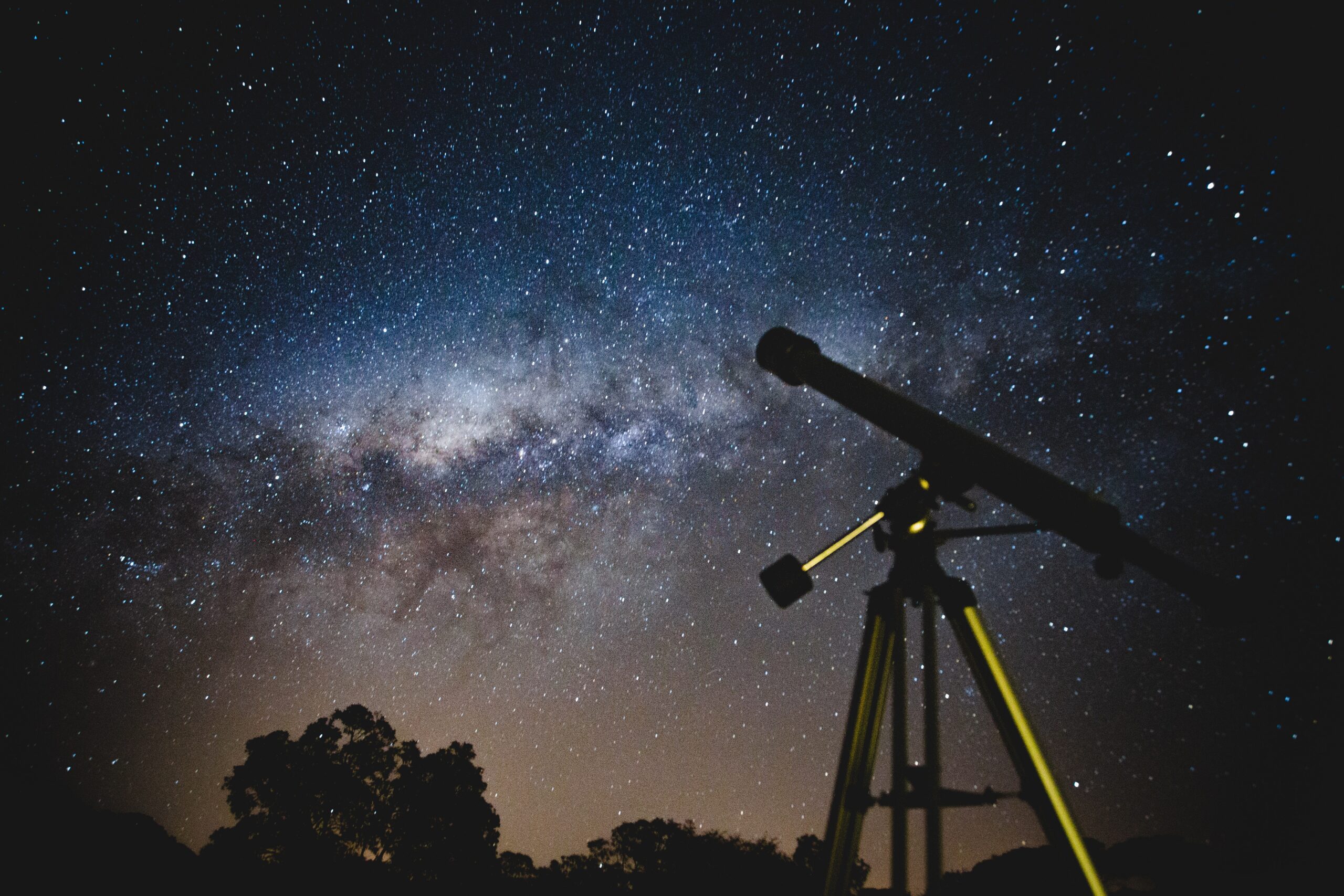How to Choose the Right Filters for Your Telescope
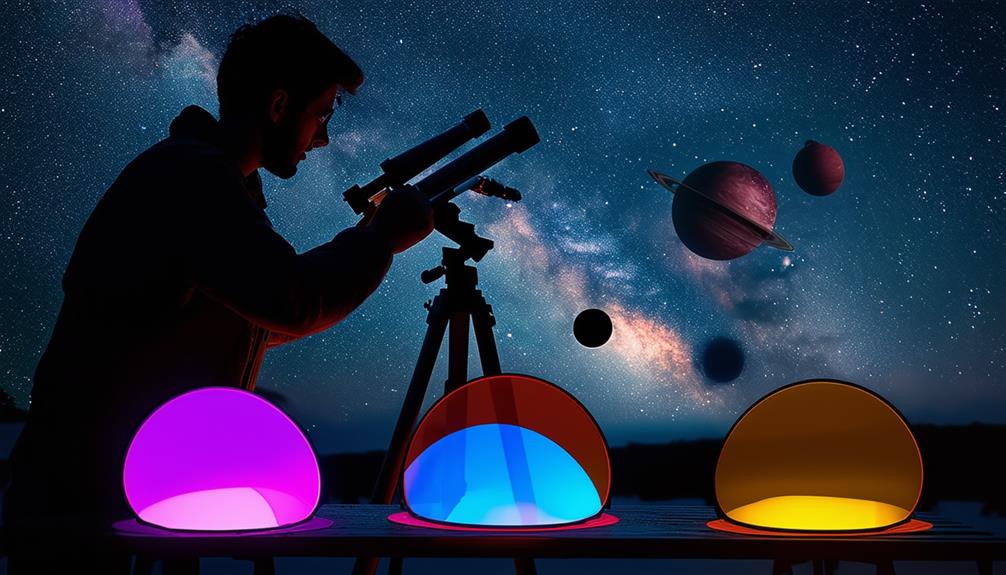
When choosing filters for your telescope, several factors are essential to optimize your viewing experience. Start by identifying the types of celestial objects you plan to observe and assessing the level of light pollution in your area.
Understanding the difference between broadband and narrowband filters is crucial, as each serves a specific purpose. Consulting experienced astronomers and comparing various brands can provide valuable insights. To ensure the filters are compatible with your telescope and of high quality, careful selection and some trial and error are necessary.
Importance of Telescope Filters
Telescope filters are essential for enhancing your views of celestial objects by reducing glare and increasing contrast. They enable you to see more details, whether observing nebulae or planetary features, by isolating specific wavelengths of light, thereby revealing hidden elements in your observations.
For nebulae, filters like the UHC (Ultra High Contrast) or narrowband filters such as the Orion Ultrablock are particularly beneficial. These filters increase contrast, making faint structures and emission lines more visible. As a result, the faint edges of nebulae become clearer, revealing stunning details that might otherwise be missed.
Planetary filters are equally important. Different colored filters, such as orange, blue, and magenta, can enhance specific features of planets. For example, an orange filter can highlight details on the Martian surface, while a blue filter can enhance the visibility of Jupiter's cloud bands. By improving contrast, these filters make it easier to discern finer planetary details, thereby elevating your overall viewing experience.
Types of Telescope Filters
When choosing telescope filters, you'll encounter narrowband and line filters designed to isolate specific wavelengths of light, making them ideal for observing nebulae and other deep-sky objects. Color and contrast filters enhance details on planets and the Moon by improving the visibility of various features. Familiarizing yourself with these options allows you to customize your observations according to your interests and your telescope's capabilities.
Narrowband and Line Filters
Narrowband and line filters significantly enhance your telescope's capability to reveal specific celestial features by blocking out unwanted wavelengths of light. Narrowband filters, such as Ultra High Contrast (UHC) and Oxygen III (OIII) filters, improve the visibility of emission and planetary nebulae by isolating particular spectral lines. These filters can make a substantial difference when observing faint details in objects like the Orion Nebula or the Helix Nebula.
Line filters, on the other hand, isolate very narrow spectral lines, such as Hydrogen-Beta (H-Beta), which excel at enhancing contrast and details in specific astronomical objects. By focusing on just a couple of wavelengths, these filters allow you to see features that would otherwise be washed out by surrounding light pollution or other wavelengths.
Here's a comparison of some common narrowband and line filters:
| Filter Type | Common Targets | Wavelengths (nm) |
|---|---|---|
| UHC | Emission Nebulae | 480-510 |
| OIII | Planetary Nebulae | 496, 501 |
| H-Beta | Emission Nebulae | 486 |
| SII | Supernova Remnants | 672 |
| H-alpha | Emission Nebulae | 656 |
Experimenting with these filters allows you to tailor your observations to specific celestial phenomena, revealing hidden details and enriching your stargazing experience. Understanding their transmission characteristics is essential for optimizing your telescope views.
Color and Contrast Filters
Enhance your celestial observations with color and contrast filters, which significantly improve the visibility of planetary features and deep-sky objects. Color filters like orange, blue, and magenta are excellent for increasing contrast and highlighting specific planetary details. For instance, an orange filter can emphasize the belts and zones on Jupiter, while a blue filter can enhance the details of Saturn's rings and Martian polar ice caps.
Contrast filters, such as UHC (Ultra High Contrast) filters and Moon filters, are invaluable for observing nebulae and lunar surfaces. UHC filters are particularly effective for viewing emission nebulae, as they block out unwanted light pollution and intensify nebula details. Moon filters reduce the glare from the bright lunar surface, making it easier to see fine details without straining your eyes.
Narrowband filters, such as the Orion Ultrablock, are highly recommended for enhancing observations of emission nebulae and planetary details. These filters isolate specific wavelengths of light, boosting the contrast and visibility of target objects. Using the right filters can significantly improve your visual experience, highlighting specific features and reducing unwanted light, thereby making your stargazing sessions more rewarding.
Enhancing Lunar Observations
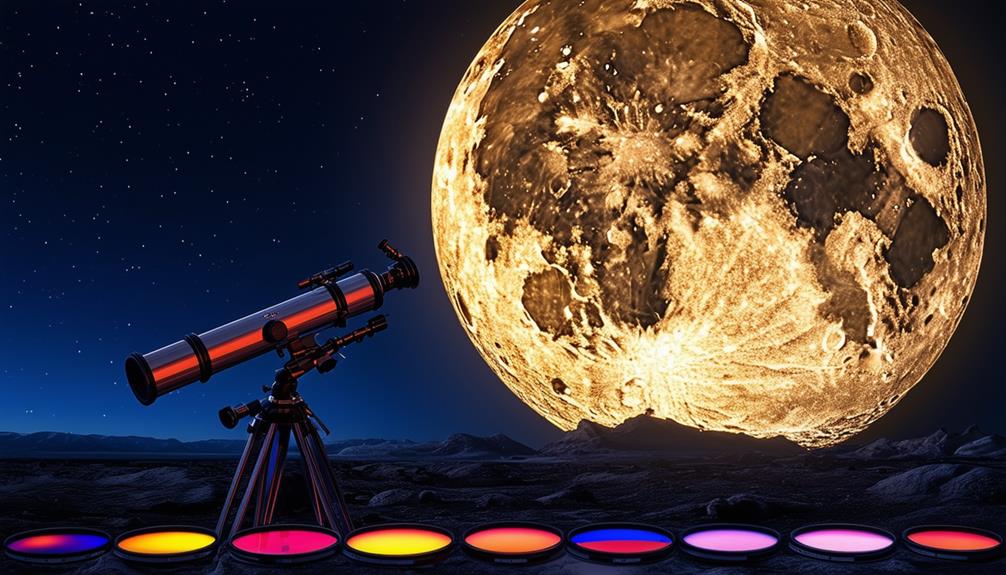
For optimal lunar observations, the use of appropriate filters significantly enhances contrast and detail. A moon filter is essential for reducing the Moon's glare, which can otherwise obscure finer surface features. By lowering brightness, a 25% neutral density lunar filter enhances detail and contrast, making craters and maria more visible.
Variable polarizing filters are another excellent choice, allowing you to adjust light transmission to suit different lighting conditions, ensuring consistently superior views. Popular options like the Svbony Moon filter can effectively enhance lunar surface features, making your observations more rewarding.
Another highly recommended option is the Baader Moon & Sky Glow filter, which not only reduces unwanted brightness but also significantly improves the visibility of lunar details. Using such filters greatly enhances the overall experience of lunar observation, allowing for the viewing of intricate details with improved clarity.
Filters for Planetary Viewing
When observing planets, using the right filters can significantly enhance specific features and overall visibility. Planetary filters such as red, green, and blue are essential for enriching details on planets like Mars and Jupiter. For instance, a red filter increases the contrast of Martian polar ice caps and surface features, making them more discernible.
On Jupiter, a green filter highlights the intricate details of its cloud belts and the Great Red Spot. Similarly, a blue filter enhances the contrast and visibility of atmospheric features, making the bands and zones more prominent. Experimenting with these planetary filters will help you determine the best one for observing specific planetary details.
For Saturn, the Baader Contrast Enhancer filter is highly recommended. This filter sharpens the details on Saturn's disc and rings, providing a crisp and detailed view. Whether observing the subtle cloud belts or the majestic rings, this filter enhances contrast and visibility, making your viewing experience more rewarding.
Deep-Sky Filter Recommendations
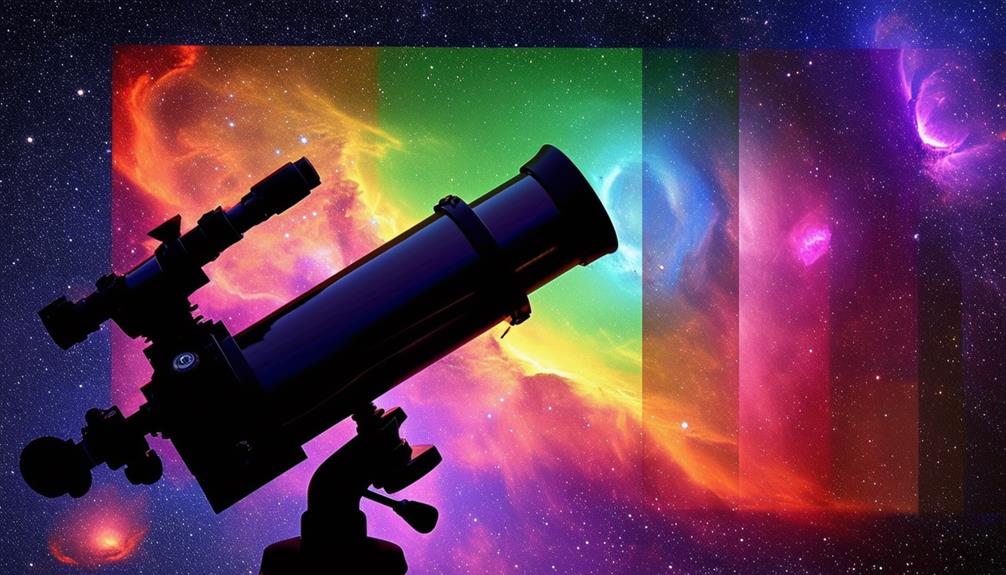
Dive into the world of deep-sky observing with the right filters to enhance your views of nebulae, galaxies, and star clusters. Ultra High Contrast (UHC) filters are essential for appreciating faint deep-sky objects. These filters block unwanted light pollution, improving visibility and highlighting intricate details.
UHC filters are particularly effective for observing emission and planetary nebulae. Brands like Orion's Ultrablock and DGM NPB filters are highly recommended for their ability to enhance contrast and reduce light pollution, thereby improving the overall viewing experience of deep-sky objects.
Another excellent option is the Tele Vue BandMate II Nebustar filter, which isolates specific wavelengths of light, making deep-sky objects more visible even in light-polluted skies. These filters are especially useful in urban or suburban settings where ambient light is a significant concern.
Experimenting with different deep-sky filters can help you find the one that best suits your observing conditions. Using the right filter can transform your telescope sessions, allowing you to see deep-sky wonders like never before.
Choosing Cost-Effective Filters
When selecting cost-effective filters, consider starting with affordable brands like Svbony for lunar and planetary observations. For nebulae, narrowband options such as the Orion Ultrablock are recommended. By experimenting with different filters within your budget, you can determine what best meets your needs. Additionally, seeking advice from experienced astronomers can help you make informed choices and avoid unnecessary expenses.
Affordable Brand Options
To maximize your telescope's potential on a budget, consider affordable filter options like the Svbony Moon Filter and the Orion Ultrablock. These filters enhance your viewing experience without a significant financial investment.
The Svbony Moon Filter is perfect for observing the moon and planets such as Jupiter, as it reduces glare and improves contrast. Meanwhile, the Orion Ultrablock is a narrowband filter designed to enhance nebula observations by blocking out most light pollution.
Here are some cost-effective filter options to consider:
- Svbony Moon Filter: Ideal for lunar and planetary viewing, offering excellent value for beginners.
- Orion Ultrablock Narrowband Filter: Enhances nebula observations, perfect for those with specific observational needs.
- Seek Expert Advice: Consult experienced astronomers to find budget-friendly filters that suit your needs.
Choosing these affordable options allows you to experiment and determine what works best for your telescope and viewing conditions without a major financial commitment. These filters cater to various observational needs and provide excellent value. Don't hesitate to seek expert advice to make informed decisions and enhance your stargazing experience.
Basic Filter Types
Understanding the various fundamental filter types can help you make cost-effective choices that improve your stargazing experience. Telescope filters come in different varieties, each serving a unique purpose. Basic filter types include lunar, planetary, deep-sky, and solar filters.
Among these, the Moon filter is an affordable option that enriches your observations by reducing the glare from the Moon, allowing you to see more details on its surface. Another cost-effective filter is the Ultra High Contrast (UHC) filter, ideal for deep-sky observations, particularly when viewing nebulae. It enhances contrast by blocking certain wavelengths of light, making celestial objects like the Orion Nebula stand out more clearly.
For those looking to delve deeper into nebula observations, narrowband filters such as the Orion Ultrablock are highly recommended. These filters isolate specific wavelengths of light emitted by nebulae, providing a clearer and more detailed view. Experimenting with different telescope filters can help you find the most suitable and affordable options for your needs.
Practical Usage Tips
Getting the best out of your telescope filters doesn't have to be costly if you know where to start. Begin with budget-friendly options like the Svbony Moon filter, which is exceptional for lunar and Jupiter observations. This filter can enhance contrast and details, making your night sky observations more rewarding without emptying your wallet.
Consider experimenting with different filters to find those that best suit your observing conditions. Here are some practical tips:
- Start Small: Begin with basic, economical filters. They can significantly improve your light management and overall viewing experience.
- Seek Advice: Connect with experienced astronomers. They can recommend filters that offer good value and specific benefits for your telescope.
- Be Patient: Mastering the use of filters takes time. Practice using them during various observations to see how they affect contrast and details.
Avoid overspending by choosing reasonably priced options tailored to your needs. You don't need the most expensive filter to enjoy clear, detailed night sky views. With patience and practice, you'll optimize the benefits of your filters and enjoy richer, more detailed observations without breaking the bank.
Factors to Consider
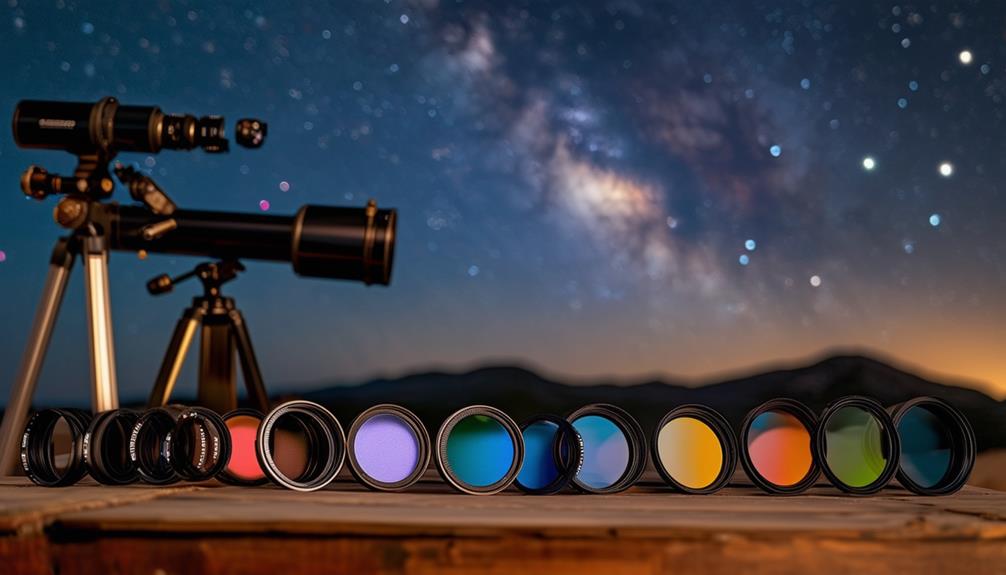
When choosing filters for your telescope, consider your observing targets and their specific characteristics. For lunar observations, a filter that reduces glare and enhances contrast will provide a clearer view. For deep sky objects, opt for filters that boost light transmission while minimizing light pollution. Knowing your local light pollution levels helps in selecting the right filter to block unwanted artificial light.
Filter compatibility is crucial. Ensure the filters fit your telescope's eyepiece to avoid any issues during observation. Consult with experienced astronomers or use online resources for recommendations tailored to your needs. Experimentation is key; testing different filters helps determine which work best for your observing conditions. Each target, from planets to nebulae, has ideal filter types that can enhance your viewing experience.
Shopping Tips for Filters
When shopping for telescope filters, start by comparing reputable brands like Orion and Astronomik to ensure quality. Verify compatibility with your telescope's eyepiece size. Consider your specific observing conditions to select filters that will enhance your viewing experience.
Compare Filter Brands
Comparing reputable filter brands such as Orion, Lumicon, Astronomik, DGM, and Thousand Oaks can guide you to high-quality options for your telescope. Each brand has unique strengths, making it worthwhile to explore their offerings in detail.
First, consider the filters' bandpass width and transmission characteristics. Brands like Orion and Lumicon are renowned for precise engineering and reliable performance. Orion filters often provide excellent value for their price, while Lumicon filters are celebrated for their durability and high-quality coatings.
Next, delve into user reviews and expert recommendations. Astronomik filters receive high praise for their exceptional clarity and minimal image distortion. DGM filters are often recommended for their specialized designs, while Thousand Oaks is known for robust build quality.
Here are some tips for effective comparison:
- Read user reviews: Seek feedback on performance and reliability from actual users.
- Compare features and prices: Examine the specific applications and costs of filters across different brands.
- Assess filter characteristics: Focus on bandpass width and transmission to identify the best fit for your needs.
Check Compatibility First
To ensure a smooth fit, double-check that the filter size matches your telescope's eyepiece diameter, typically 1.25 inches or 2 inches. This initial step prevents any frustrating fitting issues. Additionally, verify that the filter's thread size is compatible with your eyepieces. Mismatched threads can result in filters not attaching securely, which is especially inconvenient when you're out under the sky.
Your telescope type also plays a crucial role. Look for filters specifically designed for your telescope type, whether it's a refractor or a reflector. Different telescope types may require different filter designs to perform optimally. It's not just about fitting; it's about maximizing your viewing experience.
Moreover, consider the filter's transmission characteristics. Filters allow different wavelengths of light to pass through, affecting the level of detail you can observe. For instance, a filter with high transmission for certain wavelengths can enhance views of nebulae or planets, depending on your observing preferences.
Consider Observing Conditions
Observing conditions significantly impact filter performance, so tailor your choices to the typical light pollution levels and sky clarity in your area. Different filters excel under specific conditions, making it crucial to match them to your observing environment.
Consider these factors:
- Light Pollution Levels: Assess the extent of light pollution in your area. Urban areas with high light pollution require different filters compared to rural locations with dark skies.
- Brightness of Celestial Objects: Determine how filters interact with the brightness levels of the celestial objects you wish to observe. Some filters enhance faint objects, while others are better suited for bright ones.
- Light Pollution Scenarios: Experiment with various filters under different light pollution scenarios to identify which ones offer the best views.
Filter Safety and Usage
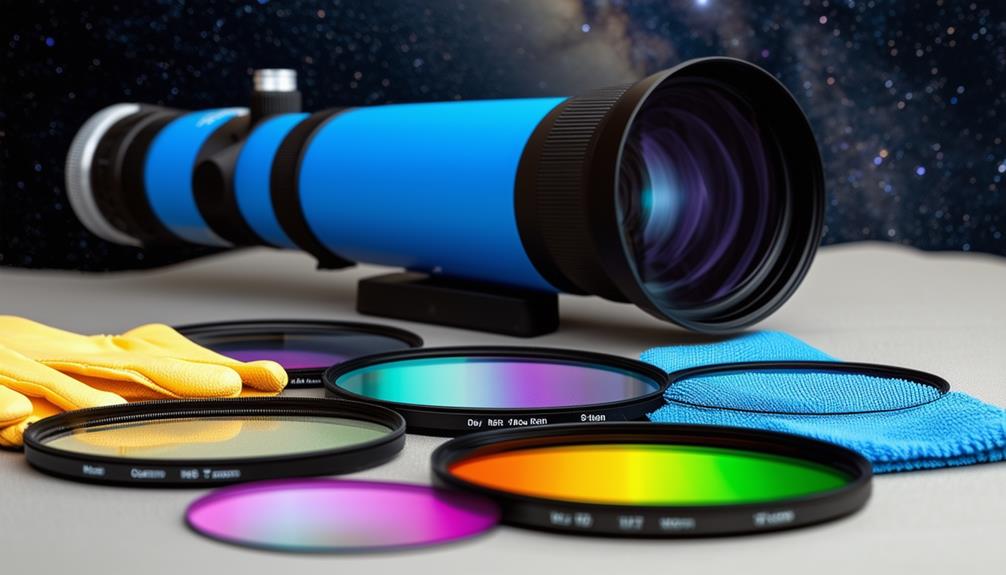
Enhancing filter safety and proper usage is crucial to protect your eyes and improve your stargazing experience. When using neutral density filters, always verify their correct attachment to the eyepiece to avoid accidental slippage. Secure handling of all filters is necessary to maintain filter safety and prevent damage to both the filter and your telescope. Understanding the proper application of each filter type ensures effective and safe usage during telescope viewing.
Solar filters demand the highest level of caution, as improper use can result in severe eye damage. Always double-check the filter's integrity before observing the sun. Conversely, lunar, planetary, and deep-sky filters, while generally safer, still require careful handling. Filters not only improve contrast and reduce glare but also enhance the visibility of specific celestial objects, ensuring a safe and rewarding observational experience.
Maximizing Your Viewing Experience
Maximizing your viewing experience starts with selecting the appropriate filters to highlight the celestial objects you're most passionate about. Filters allow you to see specific details that would otherwise be missed, enhancing your night sky observations.
Begin by considering the types of celestial objects you observe most frequently. Different filters can increase contrast and bring out fine details in planets, nebulae, and galaxies.
- Experiment: Try different filters in various sky conditions to understand their impact on contrast and visibility.
- Consult Experts: Seek advice from experienced astronomers or read reviews to make informed decisions.
- Understand Transmission: Learn the characteristics of broadband and narrowband filters to optimize your visual observations.
Broadband filters are excellent for reducing light pollution and improving the visibility of faint galaxies and nebulae. They work by selectively reducing the transmission of specific wavelengths, which helps boost contrast during visual observation. Narrowband filters, on the other hand, are tailored for viewing specific emission lines from nebulae, allowing you to see intricate details that would otherwise be washed out by surrounding light.
Investing in quality filters from reputable brands like Lumicon, Astronomik, and Orion ensures you receive the best performance and longevity. By carefully selecting and using the appropriate filters, you can greatly enrich your stargazing sessions.
Conclusion
Selecting the appropriate filters for your telescope can significantly enhance your stargazing experience. To make an informed decision, consider the types of celestial objects you intend to observe, the degree of light pollution in your area, and the compatibility of filters with your specific telescope model. Engaging with experienced astronomers and experimenting with different filters can also provide valuable insights. With the right filters, you'll achieve clearer and more detailed views of the night sky, making each observation session more fulfilling. Enjoy your stargazing journey!

